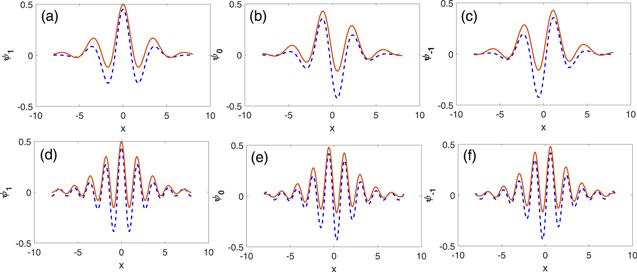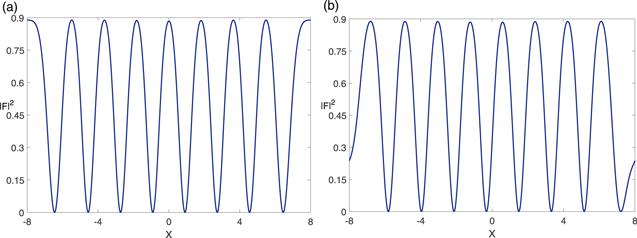 ,College of Physics and Information Engineering,
,College of Physics and Information Engineering, Received:2019-10-3Revised:2020-01-3Accepted:2020-01-6Online:2020-02-05

Abstract
Keywords:
PDF (481KB)MetadataMetricsRelated articlesExportEndNote|Ris|BibtexFavorite
Cite this article
Hong-Xia Yue, Yong-Kai Liu. Composite solitons in SU (3) spin–orbit-coupling Bose gases. Communications in Theoretical Physics, 2020, 72(2): 025501- doi:10.1088/1572-9494/ab6907
1. Introduction
Since the experimental realization of the Bose–Einstein condensation of the rubidium atom in 1995 [1], scientists have been studying the cold atomic system in depth [2–5]. A spinor Bose–Einstein condensation (BEC) that spin internal degrees of freedom are released and spin effect results in a hyperfine structure in the condensation, opening up a new research field of spin-F BEC, which has the 2F+1 complex components [5, 6]. It produces a richer variety of spin texture than single-component condensates. Spinor BECs provide an ideal testing platform to create and study novel topological excitations [7]. Most of the important experimental parameters can be precisely and highly tuned for the condensates. We can directly observe the distribution, spin structure and vortices in the experiments. What is more, the static and dynamic properties of the experiment have a good agreement with the mean field theory [5, 8–10]. It is currently considered as a powerful tool for quantum simulation.Solitons are one of the key feature in nonlinear systems that arises from a balance between nonlinear and dispersive effects. In a BEC, the nonlinearity origates from the atomic interactions, which shows spin-dependent and spin-independent nonlonear interactions for spin-1 BEC [11]. Realization of a synthetic spin–orbit coupling(SOC) in two-component BEC and spin-1 BEC has attracted great attention [12, 13]. The interaction between the motion of a particle and its spin characterized by SOC can not only stablize topological defects, but also lead to new quantum phases. One-dimensional (1D) spin-1 BEC with SOC can not only realize the helical modulation of solitons, but also lead to new quantum phases [14–16]. The developments of multi-component BEC with SOC have greatly riched the study of soliton as the cooperates or competes of the SOC with the nonlinear interactions [17]. These studies have also included the investigation of solitions in SOC spin-1 BEC and spin-2 BEC using a multiscale pertubation method [18, 19]. In a previous paper, we focus on the ground state solitons solutions in the 1D BEC with SU(2) spin–orbit coupling [14]. We have found that bright solitons have many interesting features due to SU(2) spin–orbit coupling, such as well-defined spin-sparity and multiple nodes. What is more, a gauge transformation can give the analytical solution which originate from the helical modulation. All these effects make the cold atom gases with the synthetic gauge field a rapidly developing field [20, 21]. BEC with other forms of synthetic gauge field is also an interesting question [22, 23]. SU(2) spin–orbit coupling is the coupling between SU(2) Pauli matrix and momentum. However, for spin-1 BEC system, the coupling between SU(2) spin orbit cannot fully represent the coupling effect with the system. Recently, a new coupling form-SU(3) spin–orbit coupling is proposed [23], where the internal states of three-component atoms are coupled to their momenta via a matrix structure that involves the Gell–Mann matrices. This has inspired people to study what new physics may emerge from such spin–orbit coupling, and is expected to bring new feature for 1D solitons.
In this paper, we study the ground state and metastable state of 1D spin-1 BECs with SU(3) spin–orbit coupling. By adjusting the parameters, such as the interaction coefficient and the coupling strength of the spin orbit, we apply the mean field approximation to obtain the ground state solutions and the metastable solitons solutions under different parameters in imaginary time evolution. It is found that compared with the soliton obtained in SU(2) SOC, the soliton solution obtained in the numerical simulation of SU(3) SOC shows a new fearure of mixing manifolds. We call them the composite solitons with the mixing of ferromagnetic and the antiferromagnetic states as a generic feature in the condensate, regardless of the strength of the spin-dependent interaction. The soliton in SU(2) spin–orbit coupling with attractive interactions restrict its allowed manifold to the antiferromagnetic. The composite solitons show a periodic oscillation of the magnitude ofF, which is also a new feature compared to the conventional composite solitons. Spin-1 BECs with SU(3) spin–orbit coupling may therefore be able to shed light on the study of the composite solitons, acting as a laboratory simulator.
2. Hamiltonian
We consider the one-dimensional(1D) spin-1 BEC described by $\Psi$(x, t)=($\Psi$1, $\Psi$0, $\Psi$−1). In the mean-field approximation, we theoretically describe the condensates with the coupled Gross–Pitaevskii equation [5, 24, 25]According to equation (
3. Soliton solutions
Next, we study the bright solitons for spin-1 BEC with attractive interactions and SU(3) spin–orbit coupling. Below, we fix the nonlinearity parameters c0=−1, c2=0.1, which can be realized and adjusted by Feshbach resonance in experiments, and vary the SU(3) spin–orbit coupling strength. We also check that a wide range of the value of c0 and c2 does not change the properties of the solitons.To study the solitions with SU(3) SOC, we solve equation (
Figure 1.
 New window|Download| PPT slide
New window|Download| PPT slideFigure 1.Stable bright solitons for c0=−1, c2=0.1. (a)–(c): α=1. (d)–(f): α=2. The dotted lines are numerical results by solving the GPEs with imaginary time evolution with a Gaussian initial wave package. The real curves are from the analytical solution (
For a more detailed analysis of these bright solitons, we attempt to find an analytical wavefunctions using the gauge method. It is of great interest that exact analytical solution can be acquired for 1D spin-1 BEC with SU(2) SOC. One challenge is the complexity of the nonlinear couplings, which is associated with c0 and c2 term, while the other is the spin–orbit coupling. The nonlinear couplings can be decoupled by making use of unique properties of hyperbolic functions. For a conventional spin-1 BEC, the usual bright solitonic solution for the attractive interaction is $(\tilde{{\psi }_{1}},\tilde{{\psi }_{0}},\tilde{{\psi }_{-1}})\,=A(0,{\rm{{\rm{sech}} }}({kx}),0)$. We make a gauge transformation $\psi ={e}^{i\alpha {\lambda }_{y}x}\tilde{\psi }$. Hence we obtain an analytical solution as,
For the bright soliton with SU(2) SOC, the $\Psi$1 and $\Psi$−1 exhibits the $\sin (\alpha x)$ oscillating modulation, and $\Psi$0 shows the $\cos (\alpha x)$ oscillating modulation. For the case with SU(3) SOC, the bright soliton in $\Psi$1 and $\Psi$−1 shows a more complex oscillating modulation with a different magnitude superposition of sin and cos function under the influence of SU(3) SOC.
Figure 1 illustrates the numerical soliton sulutions and the analytical solutions with SU(3) SO coulpled BEC have the same characteristic of the symmetry and the shape. The analytic solution gives a qualitative analysis of the properties of solitons $\Psi$1(x)=$\Psi$−1(−x), which replace $\Psi$1(x)=−$\Psi$−1(x) in SU(2) SOC leading to mixing manifolds of ferromagnetic and antiferromagnetic states. We also note that the numerical soliton sulutions and the analytical solutions do not coincide quite as well as SU(2) SOC, but the nodes are coincident. The main reason is that the gauge transformation exhibits some spatial modulation that cannot be eliminated through local spin rotation (different from SU(2) SOC model). The analytical solutions correspond to an approximate Hamiltonian, but it shows most of the properties of the composite soliton.
We also study the metastable states in the SU(3) SOC system. If we start from some specific initial states, the imaginary time evolution may lead to some structure as metastable solutions to the energy functional. The states have higher energy than the ground state with the same parameters. For instance, if we take a vortex-free Gaussian wave packet with a spinor (1,0,0)T as the initial state, the numerical results get the metastable state shown in figure 2. The initial state is the ferromagnetic state, and the final state is also mixing states, which is a composite soliton. It has a similar properties as the ground state we studied.
Figure 2.
 New window|Download| PPT slide
New window|Download| PPT slideFigure 2.Metstable bright solitons for c0=−1, c2=0.1. (a)–(c): α=1. (d)–(f): α=2. The dotted lines are numerical results by solving the GPEs with imaginary time evolution with a Gaussian initial wave package. The real curves are from analytical solution.
In order to study the mixing degree of the manifolds of ferromagnetic and antiferromagnetic, we calculated the value of $| F| $ in detail. For a pure antiferromagnetic state, the $| F| =0$ as in SU(2) SOC. For our composite solitons, the value of $| F| $ gradually becomes an oscillation. The value of $| F| $ gradually becomes smaller as one moves from the x space, it then becomes larger and then smaller, or vice versa. The F texture is shown in figure 3, which show a visual representation of the mixing states. When the magnetization is relatively strong, there is less antiferromagnetic ingredient. The F reflects ferromagnetic characteristics of the composite solitons.
Figure 3.
 New window|Download| PPT slide
New window|Download| PPT slideFigure 3.The magnitude of $| {\boldsymbol{F}}{| }^{2}$ along the x axis for our numerical result of metastable (a) and stable (b) for c0=−1, c2=0.1 and α=1.
In the last, we also performed real-time simulation of the two types of solitons as the initial state over a long time. The real-time evolution shows that the particle number in each hyperfine state is unchanged with dynamical stability.
4. Summary
We have studied the composite solitons in antiferromagnetic spin-1 Bose–Einstein condensates with SU (3) spin–orbit coupling. Different from the conventional SU(2) spin–orbit coupling, the novel gauge field has its own unique regulation mechanism. The composite solitons have novel symmetry and form stable states of mixing manifold. It shows a $| F| $ oscillation to reveal the degree of mixing manifold. Our results pave the way for exploring and engineering exotic solitons in the quantum system.Acknowledgments
We acknowledge support from the NSF of China under grant no. 11604193, and the supported by Innovation project for graduate students in Shanxi Province (grant no. 2019SY305).Reference By original order
By published year
By cited within times
By Impact factor
DOI:10.1103/PhysRevLett.74.3352 [Cited within: 1]
[Cited within: 1]
DOI:10.1103/RevModPhys.78.179
DOI:10.1088/1361-6633/aa50e3
DOI:10.1016/j.physrep.2012.07.005 [Cited within: 5]
DOI:10.1103/PhysRevA.72.033611 [Cited within: 1]
DOI:10.1103/PhysRevLett.101.010402 [Cited within: 1]
DOI:10.1103/PhysRevLett.81.742 [Cited within: 1]
DOI:10.1038/nphys3624
DOI:10.1103/PhysRevA.81.025604 [Cited within: 1]
DOI:10.1103/PhysRevLett.94.050402 [Cited within: 1]
DOI:10.1038/nature09887 [Cited within: 1]
DOI:10.1038/ncomms10897 [Cited within: 1]
DOI:10.1209/0295-5075/108/30004 [Cited within: 2]
DOI:10.1103/PhysRevA.90.043619
DOI:10.1142/S0217984918504043 [Cited within: 1]
DOI:10.1103/PhysRevA.87.013614 [Cited within: 1]
DOI:10.1007/s11467-017-0732-4 [Cited within: 1]
DOI:10.1103/PhysRevE.99.062220 [Cited within: 1]
DOI:10.1103/PhysRevLett.109.015301 [Cited within: 1]
DOI:10.1103/PhysRevA.99.063626 [Cited within: 1]
DOI:10.1103/PhysRevLett.119.193001 [Cited within: 1]
DOI:10.1103/PhysRevA.94.033629 [Cited within: 4]
DOI:10.1103/PhysRevLett.105.160403 [Cited within: 1]
DOI:10.1142/S0217984913501832 [Cited within: 1]
DOI:10.1016/S0021-9991(03)00102-5 [Cited within: 1]
DOI:10.1016/j.jcp.2006.01.020 [Cited within: 1]
